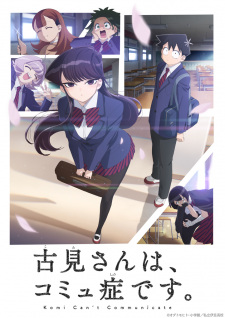Komi can’t communicate: refreshing realism courtesy of Netflix
★★★★

November 3, 2021
The anime adaptation of the popular manga “Komi Can’t Communicate” was released on Oct. 21. Netflix picked up the series and will add it to its extensive catalogue of original anime. Being on the same platform as Kakegurui, Violet Evergarden and The Way of the Househusband gives the show some big shoes to fill. Not only does the quality of the more technical aspects like animation or scoring have to align with that seen in other shows, it also has to stand-alone with an original story. It can’t rely on the reputation of its platform to push it to greatness. So, does it hold up against its competitors? Yes, one hundred percent.
“Komi Can’t Communicate” is a must-watch for anyone in school, especially after the long, lonely quarantine. The plot of the show centers around Tadano, an average student in just about all aspects, and his mission to assist Komi, a beautiful young woman with severe social anxiety, in making 100 friends before the end of the school year. The very premise of the show is very relevant to life for students at the current moment. After spending a year locked in our respective homes, many have gained first-hand experience of what it feels like to be affected by social anxiety. Having a generally knowledgeable population does place more responsibility on the creators to accurately portray this disorder, and they certainly rise to that task. It’s just humorous enough that the subject matter feels more manageable to the audience, but the effect isn’t undermined or brushed aside in any way. It’s confronted in a way that’s digestible for an audience traumatized by socialization following the pandemic.
The animation seen in “Komi Can’t Communicate” is a beautiful example of Netflix’s unique and cutting-edge style. The opening scene shows cherry blossoms falling from trees lining a road where children are walking to school, while a small black kitten watches the students as they pass. Usually, I find cherry blossoms and flowers to be a cop-out from making a scene that actually has quality art. Florals tend to be gentle and beautiful, and falling petals don’t need the complex shadow work that other elements may. In this scene though, the cherry blossoms only add to the scene. If they were removed, the scene would still be well-animated. The way the light bounces off the black hair of the students and the trunks of trees is realistic and gorgeous. The shadows receive a similar dose of realism. The very first clip of the episode could be mistaken for a photograph at a glance. While this may be frustrating for fans of the more classic, instantly recognizable, style of anime, it’s refreshing to see new techniques brought to the scene.
While plot and animation are important, what truly makes or breaks an anime is its opening sequence. Jujutsu Kaisen’s “Kaikai Kitan” by Rifti Beats and Attack on Titan’s “Shinzou wo Sasageyo!” by Linked Horizon has earned a spot in pop culture for their respective anime, with a combination of legendary music and stunning visuals. “Komi Can’t Communicate” could very well end up in a similar position. The intro showcases yet another example of incredible animation. The scenes juxtapose the realism seen in the show with a style similar to that seen in a painting. The movements are less fluid, the colors are more saturated and it’s overall a more abstract representation of the show. But no one pays much attention to the drawings. What really matters in an opening is the music. “Cinderella” by CIDERGIRL was chosen as the piece that sets the tone of the entire show, and it does an incredible job at that. It’s upbeat and dramatic when it needs to be, but it has moments that feel calmer, much like social anxiety. Of course, it’s also catchy, which is hugely important for an anime in the age of Tiktok, which only allows for quick clips of songs.
The anime industry has been fairly stagnant the past two years due to COVID-19 hitting Japan, the primary location of business, quite hard. This makes new releases even more exciting to fans of the style. “Komi Can’t Communicate” earns 4/5 stars from me, with small points knocked off simply because it’s so early in its life, and giving 5 stars to what is essentially a pilot episode doesn’t leave the room for improvement that I would like to.












